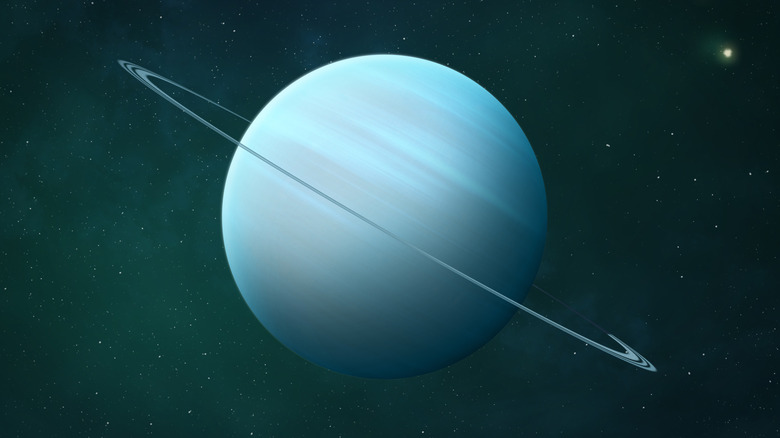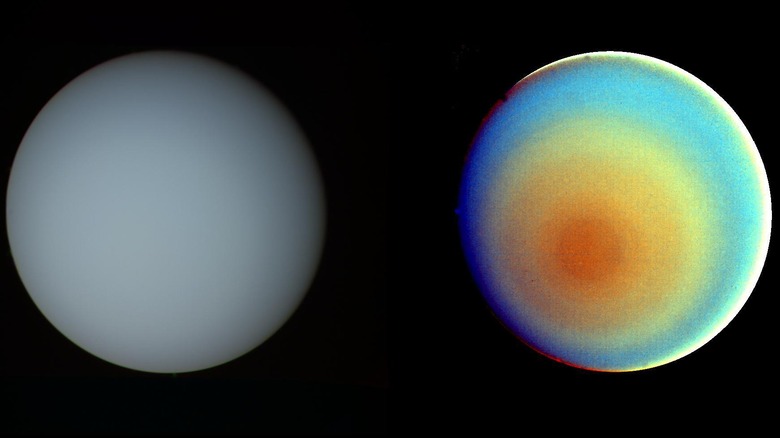The Reason Uranus Has A Blue Glow
Uranus is one of the lesser-explored planets in our solar system. It is a very long way away, orbiting around 1.8 billion miles from the sun (via NASA), and few spacecraft have ever visited there – the last manmade visitor to the planet was Voyager 2, which flew past the planet on its way out of the solar system all the way back in 1986.
Even so, we can still observe Uranus using instruments like the Hubble Space Telescope, and from these observations, we have learned that the planet is an ice giant made up of mostly icy materials and that it has a gaseous atmosphere. It also has 27 known moons, and rings – although these are almost invisible, except to very large telescopes - and one highly unusual thing about the planet is that it rotates on its side.
Perhaps the most famous thing about Uranus the average person knows is that it is a delicate blue color, which was captured beautifully in a famous image of the planet taken by Voyager 2 when the spacecraft was 5.7 million miles from the planet (via NASA).
What gives Uranus its blue glow
The lovely blue color of Uranus is because of its atmosphere, which is made up of mostly hydrogen and helium, as well as smaller amounts of methane (via Universe Today). It is this methane that gives the planet its color, as methane reflects blue light. When the light from the sun, which is made up of all the colors in the spectrum, hits the planet, the methane absorbs some of the redder colors, and the blue wavelengths are reflected off. That makes the planet appear blue.
Uranus has a distinct appearance – not only is it a striking blue color, but it is also hazy, which makes it look like the planet is glowing softly.
Recent research has proposed that the blue haze of both Uranus and Neptune, the next planet out, is also due to atmospheric conditions on the planets and that this also explains why Uranus is a lighter shade of blue and Neptune a darker one (via phys.org). The researchers suggest that it is the large amount of hydrogen sulfide, ice, and photochemicals in the planets' atmospheres that led to their hazy appearance. There are layers to the atmosphere, and as these materials move upward they get more concentrated until the methane condenses. This condensed methane makes the atmosphere look hazy.
Uranus' atmosphere is thicker than Neptune, so the methane in the atmosphere reflects more blue light, making it appear a lighter shade of blue.
Uranus in false color
Of course, Uranus only looks blue to human eyes. When the planet is perceived at different wavelengths, it can look very different. That's what you can see in the two images of Uranus captured by the NASA spacecraft Voyager 2 in 1986. To the left is Uranus in what is called true color, which uses filters to process the image as we humans would perceive it. And on the right is what is called a false-color image, where colors are used to identify features that aren't visible to our eyes.
The false-color image uses readings taken at different wavelengths, like ultraviolet, and enhances contrast to show off distinct features of the planet.
To explain the false-color image, NASA writes, "In this false-color picture, Uranus reveals a dark polar hood surrounded by a series of progressively lighter concentric bands. One possible explanation is that a brownish haze or smog, concentrated over the pole, is arranged into bands by zonal motions of the upper atmosphere. The bright orange and yellow strip at the lower edge of the planet's limb is an artifact of the image enhancement. In fact, the limb is dark and uniform in color around the planet."
This allowed researchers to see features of Uranus that would have been invisible to them had they only looked at the planet with human-like vision.


